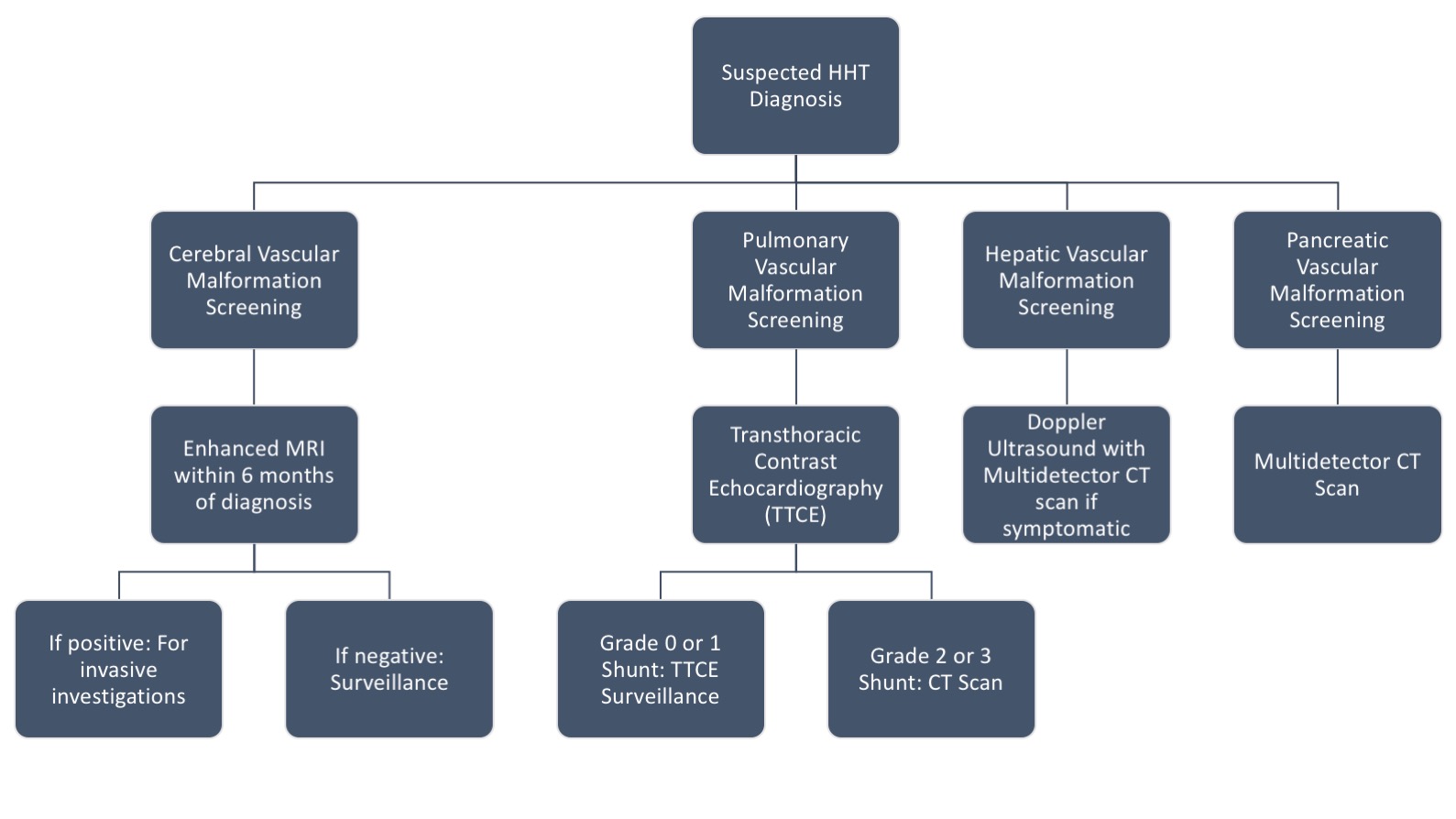Diagnostic Imaging in Hereditary Haemorrhagic Telangiectasia: A 10-Year Update
Abstract
AIMS To review the literature from 2006 – August 2016 regarding the diagnostic imaging of hereditary haemorrhagic telangiectasia (HHT), considering potential future radiological options as well as the current 2009 International Guidelines [1].
METHODS Literature review is based on a Medline, Embase and Web of Science search of the English language literature from 2006-August 2016 using all forms of the keywords ‘HHT’ and ‘radiology’ (as defined in Appendix I).
RESULTS The sensitivity of imaging modality must be balanced against radiation dose, particularly in HHT patients who frequently undergo repeat imaging. Evidence regarding optimal imaging modalities for the detection of visceral vascular malformations is generally weak, mostly consisting of observational studies. Screening for cerebral vascular malformations with enhanced MRI is widely recommended, although the requirement for subsequent surveillance is unclear. Various modalities have shown promise in the detection of pulmonary arteriovenous malformations; the largest evidence bases support the use of transthoracic contrast echocardiography with subsequent computed tomography (CT) scan if required. However, techniques free from ionising radiation, such as MRI and transcranial Doppler may allow avoidance of CT scans in the distant future. Similarly, hepatic arteriovenous malformations are currently imaged using Doppler ultrasound and CT, but 4D dynamic contrast-enhanced magnetic resonance angiography has shown promise in the research environment. Evidence regarding the imaging of pancreatic vascular malformations is sparse.
CONCLUSIONS In summary, although for the majority of visceral vascular malformations a form of ultrasound scan followed by CT is the current imaging modality of choice, a greater range of modalities with low or no radiation dose are emerging. Given the high radiation dose to which HHT patients are often exposed, research into these alternative modalities should be pursued wherever possible.
Keywords: hereditary haemorrhagic telangiectasia, Osler-Weber-Rendu, radiology, screening
Abbreviations:
HHT – Hereditary haemorrhagic telangiectasia
AVM – Arteriovenous malformation
pAVM – Pulmonary arteriovenous malformation
CT – Computed tomography
MRI – Magnetic resonance imaging
MDCT – Multi-detector computed tomography
TTCE – Transthoracic contrast echocardiography
PFO – Patent foramen ovale
Time-SLIP MRA – Magnetic resonance angiography with time-spatial labelling inversion pulse
4D -MRA – 4D dynamic contrast-enhanced magnetic resonance angiography
1. Introduction
Hereditary haemorrhagic telangiectasia (HHT), also known as Osler-Weber-Rendu syndrome, is an autosomal dominant vascular dysplasia characterised by the presence of telangiectases and arteriovenous malformations (AVMs)[2]. Patients typically present with recurrent epistaxes and multiple mucocutaneous telangiectases [3], but arteriovenous malformations – both symptomatic and silent – frequently also occur in the brain, lungs, gastrointestinal tract and liver [3]. A diagnosis of HHT is considered definitive if an individual fulfils three or more of the four Curaçao Criteria, which consist of: recurrent spontaneous epistaxis, multiple telangiectases, a first degree relative with HHT and visceral AVMs [4]. The radiological detection of visceral AVMs may therefore be required for the diagnosis of HHT in those patients who fulfil only two of the other criteria. AVMs may also result in life-threatening complications such as cerebrovascular accidents, thus screening for pulmonary, cerebral, and, in some cases, liver AVMs is recommended to allow for prophylactic treatment [1]. The current radiological techniques for the detection of AVMs are shown in Figure 1. However, techniques which minimise radiation dose should be preferentially used wherever possible; Hanneman et al (2014) determined the cumulative 20-year radiation dose from medical imaging and intervention in 246 patients with HHT, and 11% of patients were exposed to harmful radiation levels exceeding 100 mSv (n=26) [5]. Here we review the recent literature regarding alternative, low radiation imaging modalities for detecting and assessing cerebral, pulmonary, pancreatic and liver arteriovenous malformations, as compared with the current practice. Gastro-intestinal vascular malformations are generally assessed endoscopically rather than radiologically [1], and so are not included in this review.
Figure 1. Current Practice in HHT Imaging: Detection of Visceral Vascular Malformations.

2. Methods
Literature review is based on a Medline, Embase and Web of Science search of the English language literature from 2006-August 2016 using all forms of the keywords ‘HHT’ and ‘radiology’ (Appendix I). Articles were excluded and included as defined in Appendix I. Studies were generally small and of weak evidential value, and mostly consisted of case-based retrospective analyses. Here we review the evidence base behind the imaging of pulmonary, cerebral, liver and pancreatic AVMs.
3. Results
Cerebrovascular Malformations
Cerebrovascular malformations typically associated with HHT include telangiectasia, cavernous arteriovenous malformations, arteriovenous fistulas and micro AVMs [6]. Cerebral AVMs carry a small bleeding risk and catastrophic haemorrhagic sequelae sporadically occur, therefore Faughnan et al in the 2009 International Guidelines recommend screening for cerebral AVMs in both adult and paediatric patients [1]. Evidence prior to 2006 was weak regarding optimal imaging modalities for detecting cerebral AVMs in HHT patients. However, the expert panel recommended the use of magnetic resonance imaging (MRI) – with and without contrast administration – because of its lack of radiation dose and relative sensitivity for detecting non-HHT AVMs. However, no studies had actually evaluated the use of MRI in detecting AVMs in HHT patients. A more recent 2015 abstract reports the results of enhanced and unenhanced MRI scans in 100 paediatric HHT patients; unenhanced brain MRI scans detected CVMs in 40% (n=24) of the HHT cases including arteriovenous malformation (AVM), cavernomas and developmental venous anomalies (DVA), whilst the use of gadolinium enhancement reduced the proportion of lesions categorised as indeterminate from 32% to 12% [7]. However, it does not appear that these malformations were confirmed with the Gold standard for imaging – catheter angiography – presumably because of the 0.5% risk of cerebrovascular accident angiography incurs [8]. Furthermore, MRI cannot be deemed to be entirely non-invasive in paediatric patients due to the requirement for sedation.
Given that cerebral AVMs in paediatric patients under 6 years tend to be high flow pial fistulae, with higher rates of complications such as intracerebral haemorrhage [6], the 2009 panel also recommended that children with possible or definite HHT be screened for cerebral vascular malformations in the first 6 months of life or at diagnosis with an unenhanced MRI; those with positive results were referred on for more invasive investigations [1]. Follow-up monitoring for paediatric patients with negative screening scans was not discussed, but Anderson et al (2014) addressed this question of surveillance: on repeat brain MRI of 23 paediatric HHT patients none of the patients had developed further cerebral vascular malformations after an average of 3.6 years (range in months: 12-117) [9]. The timespan in which repeat neuroimaging is advised may therefore be in terms of several years; further studies may elucidate how far surveillance is required.
Pulmonary Arteriovenous Malformations
Pulmonary arteriovenous malformations (pAVMs) have been demonstrated in up to 50% of HHT patients and have been associated with serious complications such as massive haemoptysis, cerebrovascular accidents and transient ischaemic attacks, cerebral abscesses and spontaneous haemothoraces [10]. The approach to detection of pulmonary arterial malformations was thoroughly reviewed in 2015 and an algorithm developed to guide diagnostic choices [11]. We therefore only review papers published subsequently to this review to discuss any recent updates. The consensus recommendations in 2015 found transthoracic contrast echocardiography (TTCE – explained in Table 1) to remain first-line as a low risk initial test with high sensitivity for pAVM-associated right-to-left shunt.
Shunts of grade 2 or 3 should be followed up by computed tomography (CT) scanning to further evaluate lesions [11]. Previous CT studies of grade 1 shunts have never shown treatable pAVMs, therefore surveillance without CT scan was deemed adequate [11]. A further 2016 CT study of 205 HHT patients again found that no patients with grade 1 shunts of transthoracic contrast echocardiography had treatable pAVMs [12]. Although TTCE lacks ionising radiation, it is not entirely non-invasive, as it involves the injection of 10 to 20 mL of agitated saline into a peripheral vein, therefore paediatric patients may require sedation.
| TABLE 1 | TRANSTHORACIC CONTRAST ECHOCARDIOGRAPHY (TTCE) | |
|---|---|
| Method | TTCE involves the injection of agitated saline – to form microbubbles – into the right antecubital vein, whilst a concurrent echocardiogram detects the appearance of any microbubbles in the left atrium. |
| How does it work? |
The appearance of microbubbles in the left atrium indicates that blood has not passed through the pulmonary microvasculature, and has therefore been shunted from right to left either via a pulmonary arteriovenous malformation, or via an atrial septal defect. Atrial septal defects can be excluded during the echocardiogram, thus right-to-left shunts are assumed to be due to pulmonary arteriovenous malformations. |
| Interpretation of Results |
Right-to-left shunt is graded from 0 (no shunt) to 3 (significant shunting) according to the number of microbubbles visualised in the left atrium. |
Transcranial Doppler ultrasound was assessed as an alternative screening tool for pulmonary arteriovenous malformations – the technique used is explained in Table 2. The sensitivity of transcranial Doppler compared with CT scanning in the detection of right-to-left shunt was found to be 98% at rest and 100% post Valsalva in a recent case series of 86 HHT patients [13]. However, specificity was low (58%) as compared with CT detection of pAVMs; it is unclear whether this was explained by the inability of transcranial Doppler to distinguish patent foramen ovale (PFO) from pAVMs as the cause of right-to-left shunt, or whether Doppler was detecting microAVMs which were not visible on CT. Unfortunately, transcranial Doppler scan was not directly compared with the current practice of TTCE, but the inability of transcranial Doppler to exclude cardiac causes for a right-to-left shunt suggests that TTCE is likely to remain the screening investigation of choice.
| TABLE 2 | TRANSCRANIAL DOPPLER ULTRASOUND | |
|---|---|
| Method | Microbubbles of agitated saline are injected into the right antecubital vein and are detected by Doppler ultrasound of the middle cerebral artery |
| How does it work? |
The appearance of microbubbles in the middle cerebral artery indicates that blood has not passed through the pulmonary microvasculature, and has therefore been shunted from right to left either via a pulmonary arteriovenous malformation, or via an atrial septal defect. |
| Interpretation of Results |
Microbubbles in the middle cerebral artery identify the presence of a right-to-left shunt, but cannot distinguish between cardiac or pulmonary causes for shunting – further imaging is required. |
Patients with shunts of grade 2 or 3 should undergo further imaging to characterise the nature of the vascular malformation; the consensus imaging modality in 2015 was multi-detector thin cut CT without contrast with three-dimensional reconstruction [11]. A case series of 39 patients in 2016 further suggested that reconstruction using maximum intensity projection post-processing improved the sensitivity for differentiation of pAVMs from pulmonary nodules [14].
However, as previously discussed, patients with pAVMs are at risk of exposure to dangerously high levels of radiation from repeat imaging, therefore one should preferentially use low radiation techniques if possible. On chest radiograph however, small or individual pAVMs are easily missed or obscured by opacities produced by lung disease, the diaphragm or the heart [11]. MRI has not previously been recommended for the evaluation of pAVMs, but in a small 2016 study, non-contrast-enhanced magnetic resonance angiography with time-spatial labelling inversion pulse (time-SLIP MRA – explained in Table 3) was compared with digital subtraction angiography – the gold standard for pAVM characterization [15] – in HHT patients. Out of 11 patients with 38 pAVMs, all pAVMs were correctly identified, except for in one patient with image degradation due to breathing patterns [16]. Sequence acquisition was longer than for typical MRI, but as an imaging modality which does not irradiate patients this technique merits further evaluation for use in HHT patients. However, this technique has significant limitations, not least the fact that a 3T MRI scanner is required, with which not every hospital is equipped.
| TABLE 3 | TIME-SLIP MRA | |
|---|---|
| Method | Arterial blood flowing into the area of interest is ‘tagged’ by magnetically labelling the water molecules in the blood. An MRI scan is then taken (the ‘tag’ image); a control image is subsequently taken without the magnetic labelling. The difference in magnetization between control and tag images is proportional to blood flow at that exact point, so a precise map of the vasculature can be produced. |
| Advantages of Technique | No contrast required No radiation burden |
Hepatic vascular malformations
Hepatic vascular malformations frequently occur in HHT patients, but typically only approximately 8% of these malformations become symptomatic [17], in the form of high-output heart failure, portal hypertension or biliary necrosis [18]. Previous guidelines suggest that Doppler ultrasound and CT should be used to assess for liver AVMs in patients with HHT with deranged liver enzymes or associated clinical symptoms, and Doppler ultrasound should be used as a screening tool in patients with two Curaçao criteria for HHT in whom the presence of liver AVMs would confirm a diagnosis of HHT [1].
To use Doppler ultrasound alone without CT would be preferable when based on radiation dose alone, but a reduced radiation dose cannot be justified if sensitivity or specificity of the investigation is significantly compromised. In one study, on direct comparison of Doppler ultrasound versus CT, results were discordant in 46.8% of patients [19]. Ultrasound did not detect liver involvement in 5 patients in whom liver AVMs were diagnosed on multi-detector CT (MDCT), 75.9% of patients were more severely staged on MDCT than on Doppler and 24.1% were more severely staged on Doppler ultrasound than on MDCT [19]. In contrast, in a prior, larger study comparing echo-colour Doppler with multi-slice CT, the sensitivity, specificity and diagnostic accuracy of echo colour Doppler compared to CT were 95.3%, 68.0% and 91.8%, respectively [20]. The current evidence base cannot however definitively support the use of Doppler ultrasound alone.
Although CT scanning can detect hepatic vascular malformations, in a 2006 observational study the type of hepatic malformation detected on abdominal CT did not appear to predict in what way patients became symptomatic [21]. In this study 40 HHT patients with symptoms of liver vascular malformations – either symptoms of high-output cardiac failure, portal hypertension, or biliary disease – underwent abdominal CT scanning. In theory, arteriovenous shunting should predispose the patient to cardiac failure, arterioportal shunting should correlate with portal hypertension, and biliary dilatation or strictures should be associated with biliary obstruction or sepsis. However, the hepatic vascular abnormalities detected did not correlate with the presenting symptoms of the patient; for example, 46% of patients had biliary imaging abnormalities, but only 2 of these patients had biliary symptoms. In fact, the abnormalities detected by imaging only correlated with the clinical presentation in 13% of patients [21]. However, a recent study suggests that grading liver abnormalities using contrast-enhanced CT according to their morphology could predict the development of complications in HHT patients such as heart failure, atrial fibrillation and liver cirrhosis [22].
Although MRI has not classically been used in the detection of hepatic AVMs, hepatic AVMs have previously been shown to enhance on the arterial phase of MRI [23]. Direct comparison of multi-slice CT angiography (MSCTA) with 4D dynamic contrast-enhanced magnetic resonance angiography (4D-MRA – explained in Table 4) found no significant difference in measurement of mean common hepatic artery and portal vein diameters or the modalities’ accuracies in detecting liver AVMs [24]. Further confirmation of these findings would be valuable, as although MRA cannot be deemed entirely non-invasive, particularly in paediatric populations, it does not carry the significant radiation burden of CT.
| TABLE 4 | DYNAMIC CONTRAST-ENHANCED MAGNETIC RESONANCE ANGIOGRAPHY (4D-MRA) | |
|---|---|
| Method | The difference between enhanced and non-enhanced images is used to produce a map of the vasculature. Rapid repeats of scans can determine rate of blood flow. |
| Advantages of Technique | Excellent spatial resolution Can distinguish between fast and slow blood flow No radiation burden |
Another interesting role of MRI in the evaluation of liver dysfunction has been observed; increased T1 signal in the basal ganglia has been noted in the brains of a proportion of HHT patients, an observation usually identified in patients with liver failure, but in these cases in the absence of other signs of hepatic failure [25]. It is postulated that this increased signal intensity is due to manganese deposition resulting from asymptomatic porto-systemic shunting [25]. Liver vascular malformations missed on hepatic imaging may potentially be suspected following a positive result with this investigation, thus prompting further imaging to be performed.
In summary, although Doppler ultrasound followed by CT scan is still recommended for the detection of hepatic vascular malformations, further research into the possibility for MRI or MRA scanning would be valuable to maintain lower radiation burdens for HHT patients.
Pancreatic Vascular Malformations
Evidence is sparse as to the optimal imaging of pancreatic vascular malformations, as although angiography has been previously used to characterize malformations [26][27], it was deemed too invasive for use in asymptomatic patients [28]. Recently a small study evaluated the use of multi-detector CT in the imaging of pancreatic AVMs, and telangiectases were identifiable on the arterial phase; telangiectases were not always visible on portal phase however, therefore the arterial phase should be preferentially used when screening for pancreatic vascular malformations [28]. Comparison was not made with angiography to assess the specificity and sensitivity of multi-detector CT [28]. No studies of imaging modalities with lower radiation dose were found on literature review.
4. Summary
In summary, although for the majority of visceral vascular malformations a form of ultrasound scan followed by CT is the current imaging modality of choice, radiological techniques with lower radiation dose, and with potential for further research are emerging (a href=”#_edn3005″ name=”_ednref3005″ title=””>Table 5). However, in terms of changing clinical practice, the small numbers of patients diagnosed with, and treated for, HHT limit the size of research studies. Furthermore, given the serious consequences which could result from failure of detection of vascular malformations, very strong evidence in favour of alternative imaging modalities would be required before current clinical practice could change.
| TABLE 5 | FUTURE RESEARCH OPTIONS FOR HHT IMAGING | |
|---|---|
| Vascular Malformation | Low-Radiation Imaging Modality for Further Research |
| Cerebral | Debatable requirement for further surveillance if MRI is normal |
| Pulmonary | Transcranial Doppler Ultrasound Magnetic Resonance Angiography |
| Hepatic | 4D dynamic contrast-enhanced magnetic resonance angiography (D-MRA) |
REFERENCES
[1] Faughnan ME, Palda VA, Garcia-Tsao G et al. HHT Foundation International – Guidelines Working Group. International guidelines for the diagnosis and management of hereditary haemorrhagic telangiectasia. J Med Genet. 2011 Feb;48(2):73-87.
[2] Marchuk DA, Guttmacher AE, Penner JA et al. Report on the workshop on Hereditary Hemorrhagic Telangiectasia, July 10-11, 1997. Am J Med Genet. 1998 Mar 19; 76(3):269-73
[3] Plauchu H, de Chadarevian JP, Bideau A et al. Age-related clinical profile of hereditary hemorrhagic telangiectasia in an epidemiologically recruited population. Am J Med Genet 1989: 32(3): 291-297.
[4] Shovlin CL, Guttmacher AE, Buscarini E et al. Diagnostic criteria for hereditary hemorrhagic telangiectasia (Rendu-Osler-Weber syndrome). Am J Med Genet 2000: 91(1): 66-67.
[5] Hanneman K, Faughnan ME, Prabhudesai V. Cumulative radiation dose in patients with hereditary hemorrhagic telangiectasia and pulmonary arteriovenous malformations. Can Assoc Radiol J. 2014 May;65(2):135-40. doi: 10.1016/j.carj.2013.02.007. Epub 2013 Aug 6.
[6] Krings T, Ozanne A, Chng SM et al. Neurovascular phenotypes in hereditary haemorrhagic telangiectasia patients according to age. Review of 50 consecutive patients aged 1 day-60 years. Neuroradiology 2005:47(10): 711-720.
[7] Mohd Zaki F., Laughlin S., Ratjen F et al. MRI in hereditary hemorrhagic telangiectasia: Does IV gadolinium help?. Neuroradiology. Conference: 38th European Society of Neuroradiology Diagnostic and Interventional Annual Meeting, ESNR 2015 Naples Italy. Conference Start: 20150917 Conference End: 20150920. Conference Publication: (var.pagings). 57 (1 SUPPL. 1) (pp S35), 2015. Date of Publication: September 2015.
[8] Willinsky RA, Taylor SM, TerBrugge K et al. Neurologic complications of cerebral angiography: prospective analysis of 2,899 procedures and review of the literature. Radiology 2003: 227(2): 522-528.
[9] Anderson J.L., White A.J. Utility of repeat surveillance neuroimaging for cerebral arteriovenous malformations in children with hereditary hemorrhagic telangiectasia. Annals of Neurology. Conference: 43rd Annual Meeting of the Child Neurology Society Columbus, OH United States. Conference Start: 2014/10/22 Conference End: 2014/10/25. Conference Publication: (var.pagings). 76 (pp S239), 2014. Date of Publication: October 2014.
[10] Gossage JR, Kanj G. Pulmonary arteriovenous malformations. A state of the art review. Am J Respir Crit Care Med 1998: 158(2): 643-661.
[11] http://www.uptodate.com/contents/pulmonary-arteriovenous-malformations-c… Accessed 30th Aug 2016. Author: J. R. Gossage.
[12] Parra JA, Cuesta JM, Zarrabeitia R et al. Screening pulmonary arteriovenous malformations in a large cohort of Spanish patients with hemorrhagic hereditary telangiectasia. Int J Cardiol. 2016 Sep 1;218:240-5. doi: 10.1016/j.ijcard.2016.05.065. Epub 2016 May 14.
[13] Kijima Y, Gevorgyan R, McWilliams JP et al. Usefulness of Transcranial Doppler for Detecting Pulmonary Arteriovenous Malformations in Hereditary Hemorrhagic Telangiectasia. Am J Cardiol. 2016 Apr 1;117(7):1180-4. doi: 10.1016/j.amjcard.2015.12.061. Epub 2016 Jan 14.
[14] Inarejos Clemente EJ, Ratjen F et al. Utility of MDCT MIP Postprocessing Reconstruction Images in Children With Hereditary Hemorrhagic Telangiectasia. J Comput Assist Tomogr. 2016 May-Jun;40(3):375-9.
[15] Jaskolka J, Wu L, Chan RP et al. Imaging of hereditary hemorrhagic telangiectasia. AJR Am J Roentgenol. 2004;183(2):307.
[16] Hamamoto K, Matsuura K, Chiba E et al. Feasibility of Non-contrast-enhanced MR Angiography Using the Time-SLIP Technique for the Assessment of Pulmonary Arteriovenous Malformation. Magn Reson Med Sci. 2016 Jul 11;15(3):253-65.
[17] Buscarini E, Danesino C, Olivieri C et al. Doppler ultrasonographic grading of hepatic vascular malformations in hereditary hemorrhagic telangiectasia — results of extensive screening. Ultraschall Med 2004:25(5): 348-355.
[18] Garcia-Tsao G, Korzenik JR, Young L et al. Liver disease in patients with hereditary hemorrhagic telangiectasia. N Engl J Med 2000: 343(13): 931-936.
[19] Cavel A, Bleuzen A, Bertrand P et al. Comparison between Doppler ultrasonography and multiphase multidetector-row computed tomography in the detection of liver involvement in Rendu-Osler disease: An analysis of 62 patients. Diagn Interv Imaging. 2016 Apr;97(4):451-9.
[20] Buonamico P1, Suppressa P, Lenato GM et al. Liver involvement in a large cohort of patients with hereditary hemorrhagic telangiectasia: echo-color-Doppler vs multislice computed tomography study. J Hepatol. 2008 May;48(5):811-20.
[21] Wu JS, Saluja S, Garcia-Tsao G et al. Liver involvement in hereditary hemorrhagic telangiectasia: CT and clinical findings do not correlate in symptomatic patients. AJR Am J Roentgenol. 2006 Oct;187(4):W399-405.
[22] McWilliams J., Yamamoto S., Colby J. et al. A grading scheme for liver arteriovenous malformations using computed tomography in patients with hereditary hemorrhagic telangiectasia. Angiogenesis. Conference: 11th International HHT Scientific Conference Captiva, FL United States. Conference Start: 20150611 Conference End: 20150614. Conference Publication: (var.pagings). 18 (4) (pp 537), 2015. Date of Publication: October 2015
[23] Milot L, Kamaoui I, Gautier G et al. Hereditary-hemorrhagic telangiectasia: one-step magnetic resonance examination in evaluation of liver involvement. Gastroenterol Clin Biol. 2008 Aug-Sep;32(8-9):677-85.
[24] Scardapane A, Stabile Ianora A, Sabbà C et al. Dynamic 4D MR angiography versus multislice CT angiography in the evaluation of vascular hepatic involvement in hereditary haemorrhagic telangiectasia. Radiol Med. 2012 Feb;117(1):29-45.
[25] Faughnan M.E., Pauranik A., Alcaide L.P., et al. Assessment of T1 hyperintensity in basal ganglia on magnetic resonance brain imaging in patients with hereditary hemorrhagic telangiectasia. Angiogenesis 18(4):564-564 · October 2015.
[26] Chuang VP, Pulmano CM, Walter JF et al. Angiography of pancreatic arteriovenous malformation. AJR Am J Roentgenol 1977;129:1015–1018.
[27] Lande A, Bedford A, Schechter LS. The spectrum of arteriographic findings in Osler-Weber-Rendu disease. Angiology 1976;27:223–240.
[28] Lacout A, Pelage JP, Lesur G et al. Pancreatic involvement in hereditary hemorrhagic telangiectasia: assessment with multidetector helical CT. Radiology. 2010 Feb;254(2):479-84.
APPENDIX I
Search terms used:
((hereditary haemorrhagic telangiectasia) OR (hereditary hemorrhagic telangiectasia) OR (osler-weber-rendu)) AND (radiolog* OR imaging)
Inclusion criteria:
English language
Human studies
Publication date 2006 – August 2016
N > 3
Articles in abstract form were included to reduce publication bias.
Articles required the following information:
- Results regarding the sensitivity or specificity of radiological modalities in the diagnosis of HHT
| DATABASE | TOTAL SEARCH RESULTS | TOTAL PAPERS EXCLUDING REPEATS |
|---|---|---|
| Medline | 238 | 15 |
| Embase | 71 | |
| Web of Science | 175 |
Article photo credit: Hellerhoff
- Log in to post comments










